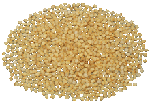TOMATOES
- Solanum lycopersicum
- Solanaceae
General information: the place of origin is South America (the territory of modern Peru, Chile, Ecuador and Columbia). In Europe tomato came from Columbia where it was grown at first as a decorative plant and then as a domestic plant. In our regions tomato is known more than 200 years. Today it grows in every region of country. It takes one of key places among vegetable crop.
Tomato fruits are characterized by high nutrient, dietary and eating qualities; they contain carbohydrates, organic acid and mineral salt. It also contains from 85,5 to 96,5 % of water, 3,5-10,5% dry basis, 0,75-0,95 % of proteins, 1,7-6,4% carbohydrates, 15-40 mg% of vitamin C, 316 mg% of kalium. Tomato fruits are used for cooking and conserving production. There are more than 100 methods of tomato cooking. It can be consumed as fresh, boiled, fried, pickling, stuffing, salted, conserving, marinaded. Tomato is irreplaceable for cooking of souses, marinades, puree, pasta and juice; regular consumption of tomato fruits stimulates hematogenesis, has beneficial effect on cardiovascular system, enforce secretion of gastric juice and action of bowels. Tomatoes are useful for people with gastro-intestinal tract disease, hypo-acidity.
Ordinary tomato (Solanum lycopersicum L.) - is one of the species of the genus Solanum (Solanum L.) of the Solanaceae family (Solanaceae Juss.). The genus contains about 900 species of annual, biennial and perennial herbaceous plants, shrubs and trees.
There are several classifications of tomato that brings some of the confusion and explains the presence of a large number of botanical synonyms. In Ukraine and Russia is considered the standard classification proposed in 1964 by the Soviet plant breeders, Academician D. Brezhnev.
According to this classification Tomato is as single genus (Lycopersicon Toum.) and divided into 3 species:
- Peruvian tomato (L. peruvianum Bezh.);
- Villouse tomato (L. hirsutum Humb. et Benp.);
- Ordinary tomato (L. esculentum Mill. или L. lycopersicum).
Ordinary tomato includes 3 subcategories:
- Wild tomato;
- Half-cultured tomato;
- Cultivated tomato.
In this way cultivated tomato has three species:
- Non-Standard tomato;
- Large-leafed tomato (potato-leafed);
- Standard tomato.
American scientist Charles Rick combines 9 species in Tomato genus that describes species diversity in the best way. Except the species that were described by D. Brezhnev, he also includes T. Chesman (L. cheesmanii) - species: the wild-growing plant that is relative of famous "black tomato" variety "Kumata", tomato Chillian (L. chilense), L. chmielewskii, L. pennellii, tomato parviflorous (L. parviflorum), current tomato (L. pimpinellifolium) they are so-called "wild tomatoes". This classification is supported in the West countries. Since 2005, according to the new classification genus Lycopersicon is no longer detached from the genus Solanum.
The main name for cultivated tomato became Solanum Lycopersicum.
Brunched stalky root system. Roots grow and form very fast. With growing by sowing roots can be in the depth of 1-1,5 m, brunching starts in the depth of 55-85 cm and spreads around 1,25 m3. With growing by seedling root system reaches the depth of 20-80 cm and spreads in diameter of 1,5-2,5 m. Plant can form additional roots at any part of stalk if there is enough humidity and feed. In natural conditions tomato can be in a height of 5 m and due to its weight it lays on the ground and takes root; it is tomato's biological particularity.
Upright villous stalks. In the beginning of life they are brashy and then they become harder. They can be in a height from 2 to 8 m. There are also law-growing plants from 30 to 80 cm. Pinnatisected leaf with wax bloom situated one by one.
Leaves can be of two types: standard smooth a little wrinkled and potatoes-leaf, they are plain, wrinkled, corrugate.
Inflorescence is recame, simple or compound, branching. The flowers are small, inconspicuous, they have different tints of yellow, often pentamerous flower, sometimes polynomial. They usually have five stamens (but maybe more), they are grown together and have conical shape. Filiform stalk ends with a pale green color. The style may be below the upper edge of the stamens at the cone of stamens or protrudes above the stamens. The first two types of styles pollinated with pollen of its flowers, and the latter can be cross-pollinated and that is used in breeding for hybrid seeds.
Set situates on the top of plant, it is big, smooth, spined, biloculine or multilocular.
Fruit is juicy, biloculine or multilocur berry with different shape, size and colour. Fruits can be small and weight 50-60 g, medium 80-100 g, big fruits weight more than 100 g. They also can weight from 500 to 1000 g. Shape is flat, round, round-flat, longish-oval, plum-shaped, pear-shaped, cherry-shaped, current tomato with smooth, ribby or misshapen skin. It can have pale-pink, bright red, light-green, light yellow, golden-orange colour. Commercial varieties and hybrids have red, pink, raspberry-red colour. Gardeners usually grow yellow tomatoes.
Seeds are small, egg-shaped or delta-shaped, flat, pointed at the bottom, light or dark-yellow usually spined that's why they have gray tint. The weight of 1000 seeds is 2,8-5,0 g. Multilocular fruit can be few-seeded or many-seeded. It keeps viability qualities for 6-8 years.










